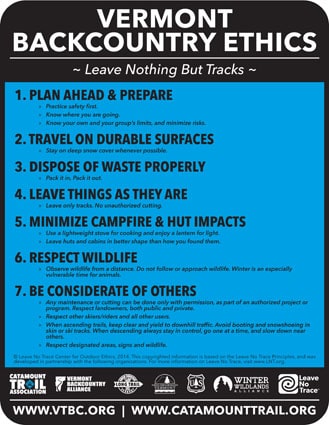©Ember Photography
A backcountry skier enjoys powder turns between the trees earlier this year. Partnering organizations are promoting safe and responsible backcountry practices statewide.
Ethics promote backcountry safety and responsible use of Vermont’s winter mountain environment
In an ongoing effort to promote the safe and responsible use of Vermont’s backcountry environment, many organizations teamed up and have finalized a new set of “Leave No Trace” guidelines for the Vermont backcountry.
Primary organizations leading the effort include: the Vermont Backcountry Alliance (VTBC), a new program of the Catamount Trail Association (CTA), in close partnership with the Vermont Department of Forests, Parks and Recreation (DFPR); the Green Mountain Club (GMC); the Green Mountain National Forest, U.S. Forest Service (GMNF, USDAFS); and the Winter Wildlands Alliance.
The Vermont Backcountry Ethics feature seven principles that have been adapted with Vermont’s winter environment in mind, from the seven core and nationally recognized guidelines for outdoor travel developed by the Leave No Trace Center for Outdoor Ethics, Boulder, Colo.
“Vermont’s backcountry community is proud to stand behind these common sense guidelines,” says Ned Houston, a volunteer with the Vermont Backcountry Alliance who helped to spearhead the project. “Our hope is that ‘Vermont Backcountry Ethics’ will help make the winter backcountry experience safer and more enjoyable for everyone.”
The “Vermont Backcountry Ethics” statement will be displayed on durable, letter-sized signs at backcountry trailheads, ski areas and other locations throughout the state, and be publicized online via the VTBC, CTA and partners’ websites. Anyone interested in helping to helping to promote Vermont Backcountry Ethics or post a sign is encouraged to contact the VTBC or CTA.
VTBC is also working closely with DFPR, the GMNF and other land managers to help update strategies for responsibly managing terrain for backcountry skiing and riding, in partnership with local communities.
The Rochester Area Sports Trails Alliance (RASTA), a pilot CTA chapter, has several projects off the ground already that will serve as models for others around the state.
Anyone interested in getting involved or supporting the VTBC are encouraged to join or donate to the CTA, which will be accepting grants and donations in support of relevant backcountry skiing and riding initiatives in Vermont.
For more info, please visit vtbc.org or catamounttrail.org.




